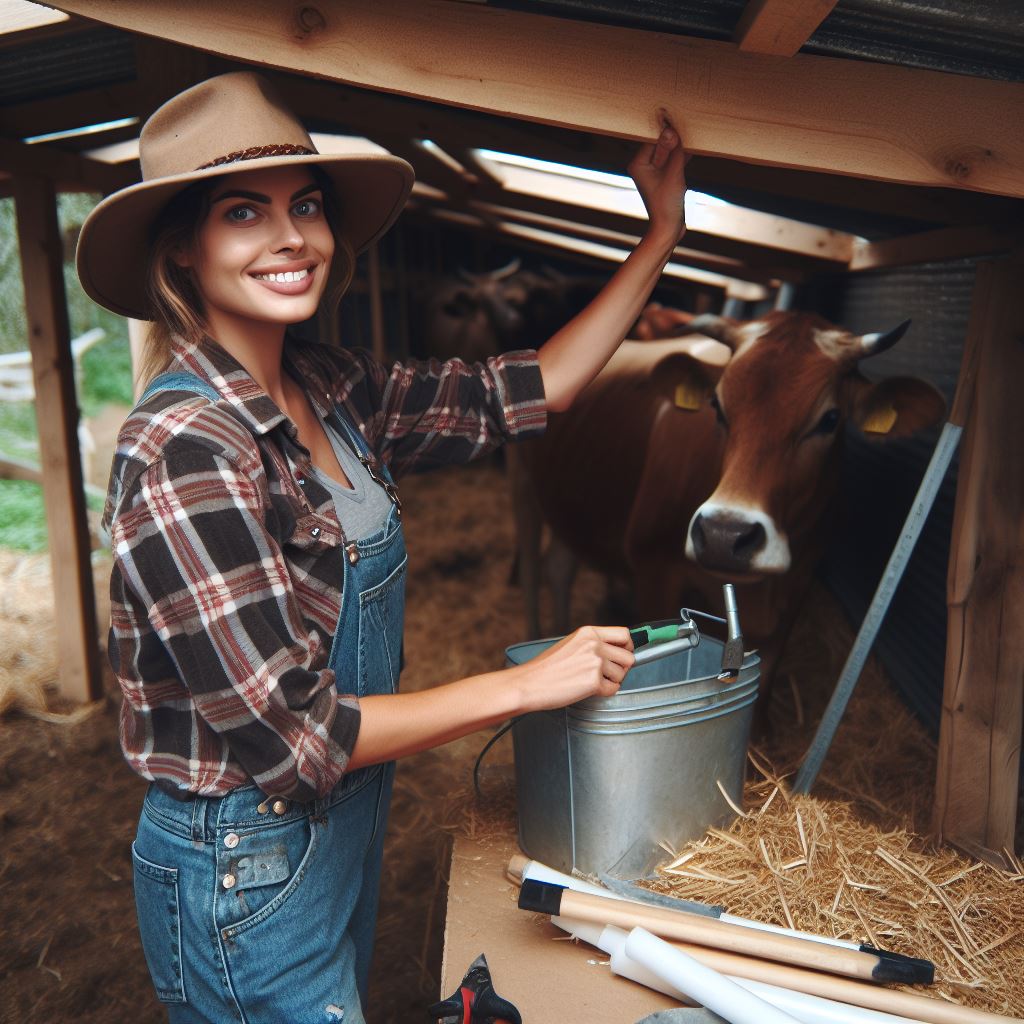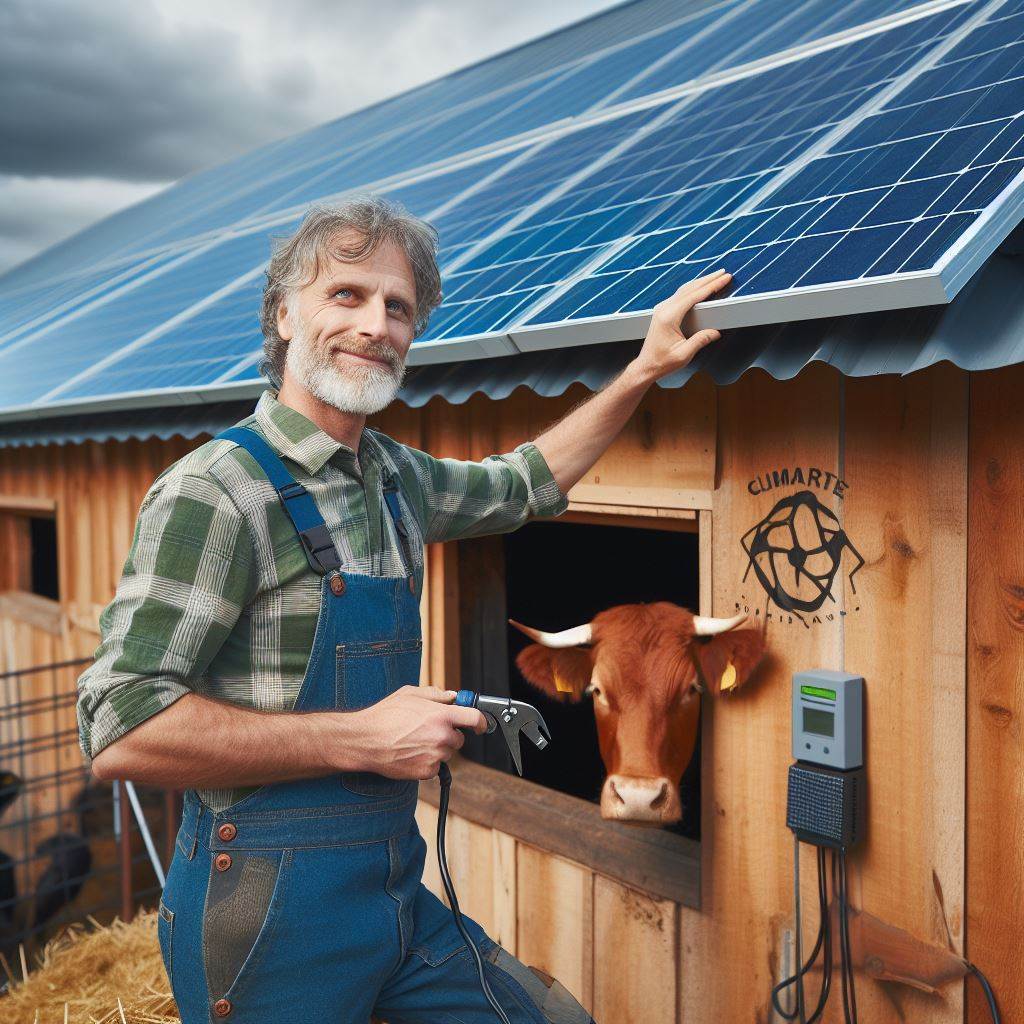Introduction
Eco-friendly livestock shelters play a crucial role in promoting sustainable farming practices and reducing our environmental impact.
These shelters are designed to provide a comfortable and safe living environment for animals while minimizing harm to the surrounding ecosystem.
In this blog post, we will delve into the significance of eco-friendly livestock shelters and their benefits.
By the end, you will have a clear understanding of why these shelters are vital for a greener and more sustainable future in the agricultural industry.
Let’s get started!
Benefits of Eco-Friendly Livestock Shelters
Reduced Environmental Impact
Eco-friendly livestock shelters play a crucial role in minimizing waste and pollution.
They utilize sustainable materials and energy-efficient systems, reducing the overall environmental impact.
By implementing eco-friendly practices, these shelters contribute to a cleaner and healthier environment.
Enhanced Animal Welfare
Eco-friendly livestock shelters prioritize the well-being of animals by providing a healthy and comfortable environment.
Proper ventilation ensures fresh air circulation, preventing respiratory issues and diseases.
Natural lighting promotes the animals’ natural behavior and enhances their overall well-being.
Temperature control systems maintain a suitable climate, minimizing stress and promoting optimal growth.
Cost Savings in the Long Run
Implementing eco-friendly practices in livestock shelters can lead to substantial cost savings in the long run.
By lowering energy consumption, these shelters reduce operating costs significantly.
Investing in sustainable materials and systems may initially require some investment.
Transform Your Agribusiness
Unlock your farm's potential with expert advice tailored to your needs. Get actionable steps that drive real results.
Get StartedHowever, the return on investment is realized through reduced energy bills and maintenance expenses.
Financial Incentives and Grants
There are potential financial incentives or grants available for farmers who implement sustainable practices in livestock shelters.
Government programs and organizations provide support to encourage the adoption of eco-friendly methods.
These incentives can cover a portion of the costs associated with implementing sustainable practices.
Farmers can benefit from reduced taxes, subsidies, or grants, making the transition to eco-friendly shelters more affordable.
Therefore, eco-friendly livestock shelters offer numerous benefits, including reduced environmental impact, enhanced animal welfare, and significant cost savings in the long run.
By implementing sustainable materials and energy-efficient systems, these shelters create a healthier and more comfortable environment for animals.
Farmers can also take advantage of financial incentives and grants to make the transition to eco-friendly practices feasible.
Read: Herbicides in Pasture Management
Design Considerations for Eco-Friendly Livestock Shelters
When it comes to constructing eco-friendly livestock shelters, there are several important design considerations that need to be taken into account.
From choosing the right building materials to incorporating energy-efficient systems and optimizing natural ventilation and lighting, every aspect plays a crucial role in creating a sustainable and comfortable environment for livestock.
In this blog section, we will delve into these design considerations and explore the various options available.
Building Materials
One of the primary considerations for eco-friendly livestock shelters is the choice of building materials.
Using recycled or renewable materials is not only environmentally friendly but also durable, ensuring the longevity of the shelter.
By repurposing materials like reclaimed wood or recycled metal, you are reducing the demand for new resources and minimizing waste.
Alternative options to traditional building materials should also be considered.
For example, bamboo is a sustainable and rapidly renewable material that can be used for structural elements or flooring.
It is incredibly strong, lightweight, and grows quickly, making it an ideal choice for eco-friendly livestock shelters.
Energy-Efficient Systems
Incorporating energy-efficient systems is essential for minimizing the environmental impact of livestock shelters.
Integrating renewable energy sources such as solar or wind power can significantly reduce reliance on grid electricity and lower operational costs.
Solar panels can power ventilation systems, lighting, and even water heating, ensuring a sustainable energy supply.
Moreover, implementing technologies that reduce energy consumption is crucial.
Energy-efficient lighting fixtures, such as LED bulbs, consume less electricity and have longer lifespans compared to traditional lighting options.
Proper insulation can also help maintain a stable indoor temperature, reducing the need for excessive heating or cooling.
Showcase Your Farming Business
Publish your professional farming services profile on our blog for a one-time fee of $200 and reach a dedicated audience of farmers and agribusiness owners.
Publish Your ProfileNatural Ventilation and Lighting
Natural ventilation and lighting play a vital role in promoting a healthy and comfortable environment for livestock.
Designing shelters to optimize natural airflow can help regulate temperature and minimize the need for mechanical ventilation systems.
This can be achieved by incorporating features like large windows, vents, or louvers that allow for the easy passage of fresh air.
Maximizing natural sunlight is equally important.
Sunlight provides warmth and contributes to the overall well-being of livestock.
Incorporating skylights or strategically placing windows can harness natural light, reducing the need for artificial lighting during the day.
Additionally, light-colored roofing materials can reflect sunlight, further reducing heat absorption.
Strategies for Optimal Ventilation
Drawing upon effective strategies for optimal ventilation is crucial to ensure a healthy atmosphere within livestock shelters.
Carefully planning the placement of vents, windows, and doors can facilitate the smooth flow of air throughout the space.
Cross-ventilation, which involves designing shelters with openings on opposite sides, encourages air circulation, preventing the buildup of stale air and minimizing the risk of respiratory illnesses for livestock.
By considering these design considerations for eco-friendly livestock shelters, you can create a sustainable and efficient environment for your animals.
Making thoughtful choices in building materials, incorporating energy-efficient systems, and maximizing natural ventilation and lighting will not only benefit the environment but also enhance the well-being and productivity of your livestock.
Read: Winter Care for Grazing Pastures

Case Studies of Successful Eco-Friendly Livestock Shelters
Implementing sustainable practices in livestock farming is crucial for both the environment and animal welfare.
Several farms and facilities have successfully adopted eco-friendly livestock shelter designs, materials, and energy-efficient systems to achieve positive outcomes.
Here are some inspiring case studies:
Examples of livestock farms or facilities that have implemented sustainable practices
- Located in a rural area, The Green Meadows Farm is known for its commitment to eco-friendly practices.
- Their livestock shelters are built using recycled and locally sourced materials.
- The designs incorporate natural ventilation, allowing fresh air to circulate throughout the shelters.
- They use solar panels to power lighting and water systems, reducing their dependence on conventional energy sources.
- The Green Meadows Farm witnessed a significant decrease in energy consumption and greenhouse gas emissions.
- The animals are more comfortable and healthier in these well-ventilated and sustainable shelters.
Details about their designs, materials used, and energy-efficient systems
- Sustainable Farm Solutions is a well-known facility that specializes in eco-friendly livestock shelter designs.
- Their shelters are made from reclaimed wood and recycled steel, ensuring minimal environmental impact.
- They incorporate rainwater harvesting systems in their designs, enhancing their sustainability efforts.
- Energy-efficient lighting and temperature control systems help reduce energy consumption.
- By implementing these sustainable practices, Sustainable Farm Solutions has significantly reduced their carbon footprint.
- Additionally, the animals experience improved living conditions, leading to better overall welfare.
The positive outcomes they have experienced, both in terms of environmental impact and animal welfare
- Harmony Ranch is a livestock facility that exemplifies sustainable practices in their shelter designs.
- They utilize locally sourced materials and prioritize natural lighting and ventilation in their shelters.
- Energy-efficient cooling and heating systems help regulate temperature effectively.
- The design of these shelters also ensures the efficient use of water resources.
- Harmony Ranch has experienced a significant reduction in water and energy consumption.
- Animal stress levels have decreased, leading to improved health and welfare.
These case studies highlight the positive impact of implementing eco-friendly livestock shelter practices.
By using sustainable materials, incorporating energy-efficient systems, and prioritizing animal welfare, these farms and facilities have achieved exemplary results.
Not only have they reduced their environmental footprint, but they have also created healthier and more comfortable living conditions for their livestock.
It is crucial for more livestock farms and facilities to follow these examples and adopt sustainable practices.
By doing so, we can collectively contribute to a healthier planet and ensure the well-being of our animals.
Read: Managing Drought in Grazing Lands
Tips for Transitioning to Eco-Friendly Livestock Shelters
Transitioning to eco-friendly livestock shelters is not only beneficial for the environment but also for the well-being and productivity of your animals.
Here are some important tips to consider during this process:
Planning and Budgeting
- Assess your current shelter and determine the changes needed to make it eco-friendly.
- Set a realistic budget that includes costs for materials, labor, and potential professional consultation.
- Research the long-term benefits of eco-friendly shelters to justify the investments.
Finding Resources
- Explore grant opportunities provided by government agencies, environmental organizations, or sustainable agriculture initiatives.
- Reach out to sustainable building consultants who can guide you through the transitioning process.
- Attend workshops, conferences, or seminars focused on sustainable livestock farming to expand your knowledge and network.
Retrofitting Existing Shelters
- Conduct an energy audit to identify areas of improvement, such as insulation, ventilation, or lighting.
- Replace traditional light bulbs with energy-efficient LED lights to reduce energy consumption.
- Install thermal curtains or shades to regulate temperature and optimize energy efficiency.
- Opt for natural cooling systems, like fans or misting systems, instead of energy-intensive air conditioners.
Constructing New Eco-Friendly Shelters
- Choose sustainable building materials, such as recycled steel, bamboo, or reclaimed wood.
- Use natural and non-toxic paints, coatings, and sealants to minimize chemical exposure to your livestock.
- Incorporate renewable energy sources, such as solar panels or wind turbines, to power the shelter.
- Design the shelter with proper insulation, including well-sealed doors and windows, to minimize heat loss.
- Implement advanced water management systems to collect and reuse rainwater or install water-efficient fixtures.
Lastly, transitioning to eco-friendly livestock shelters requires careful planning, budgeting, and resourcefulness.
By considering these tips, you can enhance the sustainability of your farm, improve animal welfare, and contribute positively to the environment.
Start your journey towards eco-friendly practices today!
Read: Livestock Feeding: Pasture vs. Supplements
Conclusion
Overall, eco-friendly livestock shelters offer numerous benefits for both the environment and animal welfare.
By utilizing sustainable practices, such as using natural materials, incorporating renewable energy sources, and implementing proper waste management systems, farmers can significantly reduce their carbon footprint and protect the planet.
These shelters also prioritize the well-being of the animals by providing adequate ventilation, insulation, and protection from extreme weather conditions.
This leads to healthier and happier livestock, resulting in better quality products for consumers.
It is important for readers to consider implementing sustainable practices in their own livestock operations.
By making small changes, such as using recycled materials, installing solar panels, and practicing rotational grazing, individuals can make a big difference.
By adopting eco-friendly livestock shelters, not only will farms become more sustainable, but they will also inspire others to follow suit.
Together, we can create a positive impact on the environment, protect animal welfare, and ensure a better future for generations to come.




